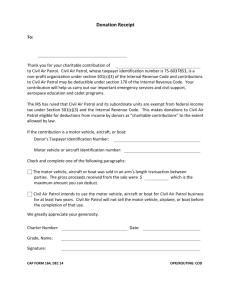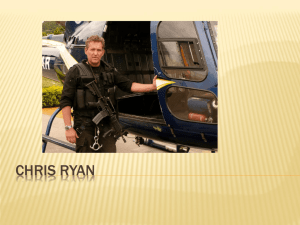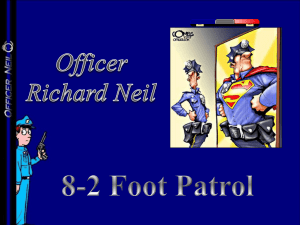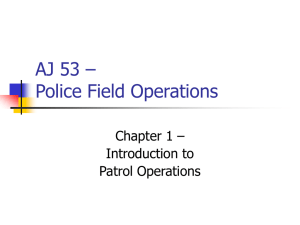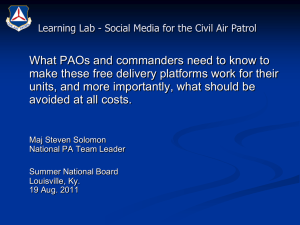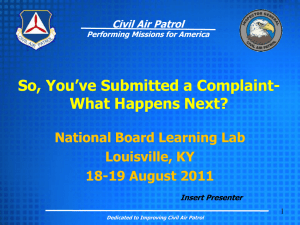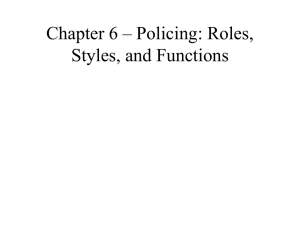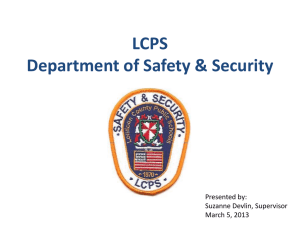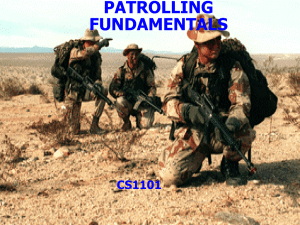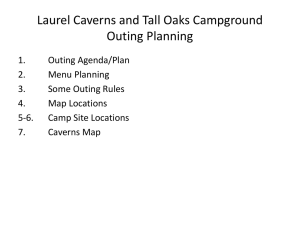AJ 53 – Police Field Operations - Sierra College Administration of
advertisement
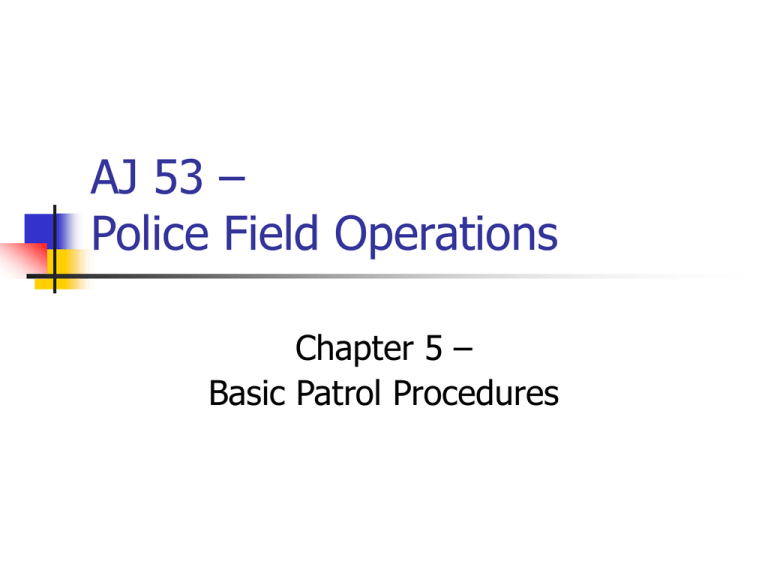
AJ 53 – Police Field Operations Chapter 5 – Basic Patrol Procedures Patrol Basics Duties and Responsibilities Purpose Moving around within a designated area Active observation Interactive participation with citizenry Visible presence to all Symbol of safety and security to law abiders Reminder to potential law breakers All types of patrol should result in daily, face-to-face contact with citizens Link to Homeland Security? Patrol Activities Administrative Activities Officer-Initiated Activities Proactive efforts based on traffic/pedestrian stops, PR contacts, etc. Assigned Calls-For-Service Community & department meetings, equipment maintenance Calls received by Dispatch Follow-Up/Directed Patrol Specific to ongoing investigations Vehicle Patrol Most common mode of patrol transportation Patrol car becomes officer’s mobile “office” Types of vehicles used for various purposes/situations Communications & Equipment General patrol duties Pursuits Marked vs. Unmarked vehicles Off-road Disadvantages? Easily recognizable Barrier to interaction with citizens Costs Types of Patrol Foot Patrol Bicycles Maximize contact with people in malls, parks, beaches, trouble spots… Allows for increased personal interaction Less mobile – slower response time Mobile, unobtrusive, access to equipment Motorcycles Primarily for traffic enforcement Types of Patrol (continued) Horses/Mounted Patrol Small Vehicles Electric vehicles, ATV’s/quads, Segways… Airplanes and Helicopters Parades, crowd control, search and rescue Welcoming and intimidating Traffic, search and rescue, narcotics, etc. Boats and Jet-Skis Waterways, holiday crowds, search and rescue/recovery General Preparation for Patrol Keep a Positive Attitude Be Curious and Suspicious Situational awareness Observational perception Wonder why people do what they do Become a Student of Human Nature Must be developed and maintained despite overwhelming negative encounters: Not all people are bad! Maintain positive off-duty relationships Learn as much as possible about people and social interactions Develop a broad base of multi-cultural experiences Be Professional, Courteous, Empathetic, and Compassionate to All! Pre-Patrol Preparation Knowledge and Information Local, state, national current events Legal updates, case-law decisions, etc. In-service training classes Beat Familiarity = Beat Integrity! Demographics, business, residential, rural Streets/numbering system, routes Floor-plans of likely calls for service Liquor stores, banks, schools, apartment complexes Pre-Patrol Preparation (cont’d) Briefing Reports Beat assignments, recent activities Read crime/incident reports from your beat Vehicle Inspection Careful and thorough! Gas, damage, lights/siren, equipment, etc. Beginning of Patrol Check-in Talk to officer going off-duty who has been working your beat Check Your Beat Cursory check of area Random, varied pattern Don’t establish permanent routine! Keep log of times & activities Homeland Security issues/locations Foot Patrol Considerations Recent trend of returning to foot patrols Increases face-to-face encounters Builds and maintains Trust & Respect Get to know people while on foot Be cautious of unethical gratuities Good opportunity for PR contacts Actively observe surroundings/goings-on You are still “on patrol” Vehicle Patrol Considerations Consider vehicle as mode of transportation In general, patrol at normal flow of traffic Slow enough to observe surroundings without impeding other drivers Windows open, radios low Patrol Patterns (p. 168) Don’t “hide” inside patrol car Get out and walk around Spiral, zigzag, quadrant, cloverleaf Driving Factors Vehicle, traffic, weather, fatigue, pursuits EVOC training Plainclothes Patrol Unmarked vehicles Advantages In uniform or plain clothes Stealth and anonymity Observation and approach to illegal activity Immersion in crowds, special events Challenges Identification Communications Weapons Contact with uniformed officers Building Checks In vehicle or on foot Check vehicles/persons in area or parking lot Loud vs. quiet approach Need to physically “shake some doors” Note floor plans for future reference Communication with Dispatch, other officers Check for signs of forced entry Broken locks, pry marks, tools, etc. Building Checks (continued) Open Door Someone inside? Enter alone or wait for partner? Weapon drawn? Vision adjustment Flashlight vs. light switch Checking interior Employee? Janitor? Burglar? Lighting issues Consider K-9 if available Listen! Doors may be open, locked, etc. Expect someone to be there! Make contact with Responsible Party Crime-Prevention Checks Excellent PR tool! Residential Vacation checks After theft, burglary, etc. Commercial & Institutional Good use of foot-patrol time Offer advice to business owners Check business licenses Attractive Nuisances Be aware of potentially hazardous or troublesome locations… Vacant/Abandoned buildings Teen “party houses” Parks or playgrounds at night Drug use/sales Liquor stores, bars, etc. Gangs and Gang Activities Not just a “big city” problem Pre-teens to young adults Typical activities/crimes Tagging, graffiti, vandalism Theft, Robbery, Burglary Alcohol use, Drug use/sales Fights & Weapons Patrol Officer’s responsibilities? Surveillance Surveillance = observing a place, person, or object for the purpose of… Identification Developing information Determining relationships Gathering evidence Loose vs. Fixed surveillance Surveillance Considerations Gather as much intelligence as possible Discreet communications Combine various methods Before and during operation Foot, vehicle, individuals, and teams Develop a plan for contingencies Expect the unexpected! Stakeouts Fixed surveillance for suspect, crime Planning and preparations Notifications and cooperation Location and equipment Food, water, bathroom Communications Relief of personnel Plan for contingencies Specialized Enforcement SWAT, Gangs, Narcotics, Vice, etc. Special training/equipment required Somewhat autonomous but still within Department policies & procedures Requires communication/coordination with uniformed patrol Undercover Assignments Requires careful planning/preparation May require memorization of new identity/personal history Challenges of isolation and separation May have to build relationships with less-than-desirable people Impact on family?
